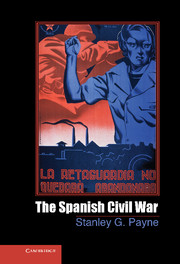Book contents
- Frontmatter
- Contents
- Chronology of Major Events
- Glossary
- Preface
- Introduction Civil War in Twentieth-Century Europe
- 1 Modernization and Conflict in Spain
- 2 From Revolutionary Insurrection to Popular Front
- 3 The Breakdown of Democracy
- 4 The Military Insurrection of the Eighteenth of July
- 5 The Battle of Madrid – the First Turning Point
- 6 Revolution
- 7 Terror
- 8 A War of Religion
- 9 Franco's Counterrevolution
- 10 Foreign Intervention and Nonintervention
- 11 Soviet Policy in Spain, 1936–1939
- 12 The Propaganda and Culture War
- 13 A Second Counterrevolution? The Power Struggle in the Republican Zone
- 14 The Decisive Northern Campaigns of 1937–1938
- 15 The War at Sea and in the Air
- 16 Civil Wars within a Civil War
- 17 The War in Perspective
- Conclusion Costs and Consequences
- Select Bibliography
- Index
- References
5 - The Battle of Madrid – the First Turning Point
Published online by Cambridge University Press: 05 September 2012
- Frontmatter
- Contents
- Chronology of Major Events
- Glossary
- Preface
- Introduction Civil War in Twentieth-Century Europe
- 1 Modernization and Conflict in Spain
- 2 From Revolutionary Insurrection to Popular Front
- 3 The Breakdown of Democracy
- 4 The Military Insurrection of the Eighteenth of July
- 5 The Battle of Madrid – the First Turning Point
- 6 Revolution
- 7 Terror
- 8 A War of Religion
- 9 Franco's Counterrevolution
- 10 Foreign Intervention and Nonintervention
- 11 Soviet Policy in Spain, 1936–1939
- 12 The Propaganda and Culture War
- 13 A Second Counterrevolution? The Power Struggle in the Republican Zone
- 14 The Decisive Northern Campaigns of 1937–1938
- 15 The War at Sea and in the Air
- 16 Civil Wars within a Civil War
- 17 The War in Perspective
- Conclusion Costs and Consequences
- Select Bibliography
- Index
- References
Summary
Franco left the Canaries on July 18 and arrived by plane in Spanish Morocco on the following day to assume command of the key forces stationed there. He had first gained his reputation as a combat officer in the long and arduous campaigns between 1912 and 1926 to put down the native insurgency in the Protectorate, and his prestige among the military in Spanish Morocco was unrivaled. The entire Protectorate fell under the control of the Nationalists at the outset, providing them with a military base and the only combat-ready units in the army. The insurgent leaders quickly began to move troops to the mainland, but only about 700 were transferred during the first twenty-four hours before the Republican navy established a blockade.
Once Franco had joined the insurrection, he immediately assumed a major role, all the more important given that the nominal commander-in-chief, General José Sanjurjo, died in a plane crash on July 20 when attempting to leave his Portuguese exile for what would be called the zona nacional – the “Nationalist zone.” Mola then created a governing body for the insurgents on July 23, when he established a multimember Junta de Defensa Nacional in Burgos in the far north, led by General Miguel Cabanellas, the most senior officer among the rebel commanders. Franco would only officially join it on August 3, but from the beginning he exercised independent command in Morocco, in which he took the initiative on both the military and the diplomatic fronts.
- Type
- Chapter
- Information
- The Spanish Civil War , pp. 82 - 92Publisher: Cambridge University PressPrint publication year: 2012



